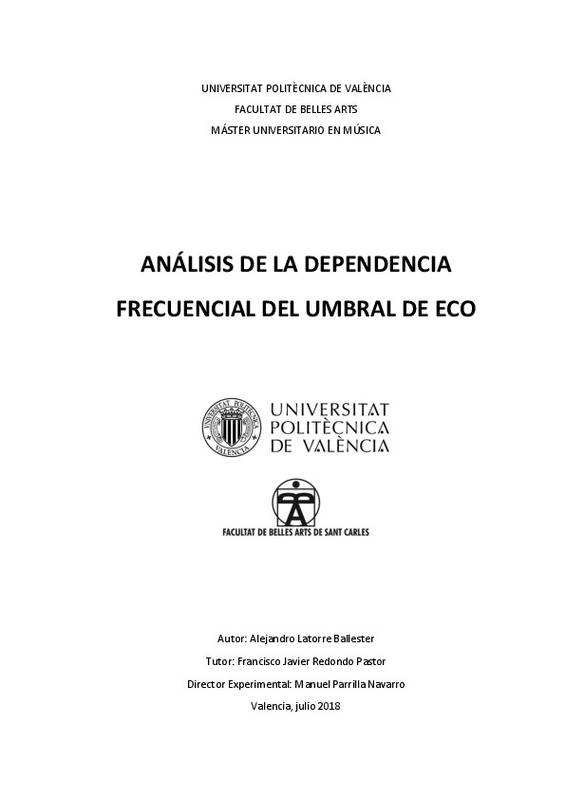JavaScript is disabled for your browser. Some features of this site may not work without it.
Buscar en RiuNet
Listar
Mi cuenta
Estadísticas
Ayuda RiuNet
Admin. UPV
ANÁLISIS DE LA DEPENDENCIA FRECUENCIAL DEL UMBRAL DE ECO
Mostrar el registro sencillo del ítem
Ficheros en el ítem
| dc.contributor.advisor | Redondo Pastor, Francisco Javier
|
es_ES |
| dc.contributor.advisor | Parrilla Navarro, Manuel Jesús
|
es_ES |
| dc.contributor.author | Latorre Ballester, Alejandro
|
es_ES |
| dc.date.accessioned | 2018-10-23T06:43:42Z | |
| dc.date.available | 2018-10-23T06:43:42Z | |
| dc.date.created | 2018-07-19 | es_ES |
| dc.date.issued | 2018-10-23 | es_ES |
| dc.identifier.uri | http://hdl.handle.net/10251/111093 | |
| dc.description.abstract | En el presente trabajo se ha procedido a determinar el umbral de percepción del eco a un grupo de personas. Este estudio se ha realizado a un grupo de sujetos de diferentes edades, con y sin conocimientos de música, y ambos sexos. A partir de este análisis y de los datos obtenidos se procederá a determinar, si es posible, si el umbral de eco depende de la frecuencia y de qué manera y si existen diferencias entre el sexo de las personas, edades y formación musical. El análisis de la dependencia frecuencial del umbral de eco consistirá en un estudio psicoacústico realizado con una aplicación desarrollada a través de entorno de Matlab. El estudio consiste en la escucha de dos eventos sonoros (dos ruidos) repetidos con retardos diferentes todos ellos en siete frecuencias diferentes (250, 500, 1000, 2000, 4000 y 8000 Hz). Los resultados confirman que el umbral de eco presenta variaciones en función de la frecuencia a la que se emiten los sonidos y éste realiza una curva esperada, es decir, a frecuencias cercanas a las que el oído es más sensible, es más fácil distinguir que hay eco. En cuanto a la respuesta sobre si existen diferencias entre el sexo de las personas, edades y formación musical, no se pueden extraer conclusiones muy precisas. | es_ES |
| dc.description.abstract | In the present work we have proceeded to determine the threshold of perception of the echo to a group of people. This study has been done to a group of subjects of different ages, with and without knowledge of music, and both sexes. From this analysis and the data obtained, we will proceed to determine, if possible, if the echo threshold depends on the frequency and in what way and if there are differences between the sex of the people, ages and musical formation. The analysis of the frequency dependence of the echo threshold will consist of a psychoacoustic study carried out with an application developed through the Matlab environment. The study consists in listening to two sound events (two noises) repeated with different delays, all of them in seven different frequencies (250, 500, 1000, 2000, 4000 and 8000 Hz). The results confirm that the echo threshold has variations depending on the frequency at which the sounds are emitted and this makes an expected curve, that is, at frequencies close to which the ear is more sensitive, it is easier to distinguish that there is echo. As for the answer about whether there are differences between the sex of people, ages and musical training, you can not draw very precise conclusions. | en_EN |
| dc.language | Español | es_ES |
| dc.publisher | Universitat Politècnica de València | es_ES |
| dc.rights | Reconocimiento - No comercial - Sin obra derivada (by-nc-nd) | es_ES |
| dc.subject | Frecuencia | es_ES |
| dc.subject | Umbral de eco | es_ES |
| dc.subject | Eco | es_ES |
| dc.subject | Percepción acústica | es_ES |
| dc.subject | Psicoacústica | es_ES |
| dc.subject | Frequency | en_EN |
| dc.subject | Echo threshold | en_EN |
| dc.subject | Echo | en_EN |
| dc.subject | Acoustic perception | en_EN |
| dc.subject | Psychoacoustics | en_EN |
| dc.subject.classification | FISICA APLICADA | es_ES |
| dc.subject.other | Máster Universitario en Música-Màster Universitari en Música | es_ES |
| dc.title | ANÁLISIS DE LA DEPENDENCIA FRECUENCIAL DEL UMBRAL DE ECO | es_ES |
| dc.type | Tesis de máster | es_ES |
| dc.rights.accessRights | Abierto | es_ES |
| dc.contributor.affiliation | Universitat Politècnica de València. Departamento de Física Aplicada - Departament de Física Aplicada | es_ES |
| dc.description.bibliographicCitation | Latorre Ballester, A. (2018). ANÁLISIS DE LA DEPENDENCIA FRECUENCIAL DEL UMBRAL DE ECO. http://hdl.handle.net/10251/111093 | es_ES |
| dc.description.accrualMethod | TFGM | es_ES |
| dc.relation.pasarela | TFGM\91216 | es_ES |






